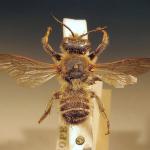A key is available in Perkins (1925). Else & Edwards (in press) will also have a key. Formerly included in Chalicodoma, now treated as a subgenus of Megachile.
There are no recent records of M. ericetorum in Britain. There are two specimens collected by Smith in 1844 from Weybridge, Surrey and there are a few other unsubstantiated records as well from around this time from Bristol, Sandwich and Southampton. The Weybridge specimens remain the only authenticated records for this species in Britain.
Globally, M. ericetorum is found from Belgium, France, Spain across to Romania, Italy and Greece. Further afield it has been recorded in Turkey and China and recently (2010) a single female was collected from Canada though it is not yet thought to be established there.
Listed in Shirt (1987) as Extinct as there are no post-1900 records.
In Britain the habitat is not known, although the Weybridge area is sandy. In Europe it occupies a number of habitat types.
Univoltine. In Europe M. ericetorum flies from June to the end of August. One of the 1844 Weybridge examples was collected on 2nd July.
On mainland Europe it is known to nest in pre-existing holes in dead wood and will nest in artificial bee tubes, as with other megachilines. Perkins (1925) notes that it differs from other Megachile in that it uses a resinous material rather than cut pieces of leaves to form its cells. Modern literature notes mud pellets as well as resin in the construction of the cells.
In Germany, it is known to visit Fabaceae and Lamiaceae.
The bee Coelioxys aurolimbata (Förster) is noted as a cleptoparasite on the continent.
2019


